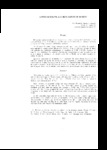Nitrificación en algunos suelos de México

View/
Date
1968Author
González Camargo, Hernando
Echegaray A., Alfredo
Baldovinos de la P., Francisco
Metadata
Show full item recordAbstract
El presente trabajo se efectuó con el propósito de conocer la capacidad nitrificante de seis suelos de la parte central de México, con diferentes características físicas, químicas, biológicas y desarrollados bajo condiciones ambientales diferentes. En el campo los suelos fueron tratados con soluciones acuosas de sulfato de amonio y urea conteniendo respectivamente 100 ppm de nitrógeno. A los 4 y 10 meses después de haber sido aplicados los fertilizantes nitrogenados, se cuantificó el N-NH4 y N-NO3 presentes, así como la flora nitrificante. Los resultados indican que comparativamente con los suelos testigos, a los 4 meses se encuentran las mayores cantidades de N-NO3 en los suelos tratados con sulfato de amonio. En el experimento de incubación en el laboratorio, los suelos fueron tratados con las soluciones acuosas de sulfato de amonio y urea y sometidos a condiciones de humedad y temperatura controladas. La producción de nitratos fue estadísticamente significativa en todos los suelos a excepción de los del Lago de Texcoco y San Juan del Río. Se encontró también que la mayor producción de nitratos correspondió a los suelos tratados con sulfato de amonio. ABSTRACT: This study was carried out in order to find out the different nitrifying capacities of six soils of the central part of Mexico. These soils have been developed under different environmental conditiond. Thus, the six soils present different characteristics from the physical, chemical, and biological point of view. Water solutions of ammonium sulfate and urea containing 100 ppm of nitrogen respectively, were applied to the soils in the field. After four months of having applied the fertilizers, and then, after ten months, the amounts of N-NH4 and N-NO3 were measured in each soil. Also, it was estimated the amount of nitrifying flora. Results indicate that in comparison to the check soils, the ammonium sulfate treated soils had the largest amounts of N-NO3. In the incubation experiment carried out in the laboratory, under controlled temperature and humidity, water solutions of urea and ammonium sulfate were added to the soil samples. The production of nitrates was statistically significat for all the soils except for those of Texcoco and San Juan del Río. It was also found that the highest production of nitrates was that of the soils treated with ammonium sulfate.
Collections
- Agrociencia [55]
